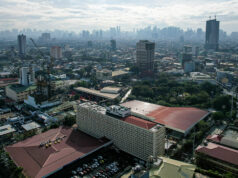Philippines still seeking lower US tariff

GLOBAL TRADE has “responded well” to Washington’s broader relaxation of tariffs, though uncertainty still hangs over the outlook as Manila continues to negotiate the lowering of the 19% reciprocal duty on its exports, the Department of Economy, Planning, and Development (DEPDev) said.
“I think that the global trade in many countries has responded well to the improvement,” DEPDev Secretary Arsenio M. Balisacan told reporters on the sidelines of a Senate hearing on Nov. 18.
“But still, it does not mean that uncertainty has disappeared. It’s still out there.”
The Philippines continues to press for a lower reciprocal tariff even after most of its agricultural exports were exempted under US President Donald J. Trump’s latest executive order, Mr. Balisacan said.
Other goods from the Philippines are still slapped with a 19% reciprocal tariff when they enter the US. However, Mr. Trump’s latest executive order exempted hundreds of agricultural products from the reciprocal tariffs starting Nov. 13.
The Department of Trade and Industry earlier said the latest order meant that over $1 billion worth of Philippine agricultural exports are now exempted from the 19% US reciprocal tariff.
Key agricultural exports exempted from the reciprocal tariff include coconut (copra) oil, both crude and other than crude; fruit juices; processed pineapples; desiccated coconuts; prepared or preserved coconuts; bananas, other than pulp; dried guavas, mangoes, and mangosteens; frozen tuna fillets; rice wafer products; and confectionery products.
Mr. Balisacan said the tariff exemption will boost productivity of coconut farmers, as well as strengthen their export capacity.
Executive Secretary and former Finance chief Ralph G. Recto said the tariff exemptions mark a positive step for Philippine exports and agriculture, adding they could help drive economic growth.
“It’s positive for us. I think President Trump realized that imposing tariffs on agriculture is inflationary, so he removed them. That’s good for us,” he said on the sidelines of a Senate hearing on Nov. 18.
‘EXPORT MORE’
Meanwhile, the Department of Agriculture (DA) is ready to support Philippine farmers in expanding their exports to the US.
“The path is clear. Now people can plan, invest, and expand. So, that’s good. As far as the DA is concerned, we have to start planting more… so that we can export more to the US,” Agriculture Secretary Francisco P. Tiu Laurel, Jr. told reporters on the sidelines of the 3rd Philippine Hydro Summit on Wednesday.
Mr. Laurel said the US order has helped calm the anxiety of Philippine exporters of coconuts, bananas and pineapples.
The Agriculture chief said that the 19% US reciprocal tariff, which was implemented starting August, had earlier created uncertainty for the industry.
“But now, everything is clear… The President’s directive was to support all of our export products. And that will be our banner programs for next year,” Mr. Laurel said.
The Philippine Exporters Confederation, Inc. (Philexport) said the exemption of Philippine exports such as coconuts, pineapples, bananas, and mangoes from the 19% US reciprocal tariffs is expected to “improve demand, stabilize prices, and directly benefit exporters, farmers, and rural communities across the Philippines.”
“This is a positive outcome of our sustained collaboration and engagements with key stakeholders and partners to convey the need for certain exemptions and maintain the competitiveness of Philippine exports, especially those products not locally produced in the US,” Sergio R. Ortiz-Luis, Jr., Philexport president and chief executive officer, said.
Philippine Chamber of Commerce and Industry President Enunina V. Mangio said the exemptions provide “much-needed relief to exporters, help safeguard jobs, and strengthen the competitiveness of Philippine products.”
For his part, University of Asia and the Pacific Associate Professor George N. Manzano said the Philippines should continue negotiations with the US for a lower reciprocal tariff.
“However, we are still not better off compared to the period before President Trump introduced those reciprocal tariffs. So, the Philippines should continue negotiating for a reduction of the 19% reciprocal tariff,” he said in a Viber message.
Mr. Manzano noted that the removal of reciprocal tariff does not mean Philippine exports are duty-free, as the original Most Favored Nation tariff will still be applied.
If the US extends the tariff rollback to all trading partners, the Philippines’ relative competitiveness would remain unchanged, he added.
“This US tariff exemption is a game-changer for Philippine exporters. Over $1 billion worth of goods — led by coconuts, coffee, cocoa, and processed fruits —will now enter the US duty-free,” Jonathan L. Ravelas, a senior adviser at Reyes Tacandong & Co., said in a Viber message to BusinessWorld on Wednesday.
He also said the tariff break may offer a chance to scale up value‑added products of farmers and agri‑businesses.
“My advice? Move fast, ensure quality, and lock in supply reliability — this window won’t stay open forever,” he said.
For his part, Foundation for Economic Freedom President Calixto V. Chikiamco said the exemption is “self‑serving,” and would favor the US more than the Philippines.
“It’s meant to lower food prices in the US since affordability has become a hot political issue,” he said in a Viber message on Wednesday.
Meanwhile, Ivan Tan, director and lead analyst for Southeast Asia at S&P Global Ratings, said while the tariff exemption is “good,” the Philippines will unlikely see a significant impact as goods remain a small component of the country’s exports.
“I think the impact will be quite mild,” he said in a webinar on Wednesday. “To start with, the dependence of the Philippines’ economy on export… is low. It’s quite small.”
S&P Global has said the US tariff policies could pose downside risks to economies and financial markets in the Asia-Pacific region.
“There is a high degree of unpredictability around US policy implementation and possible responses — specifically about tariffs — and the potential effect on economies, supply chains, and credit conditions,” it said in its recent Global Banks Outlook 2026 report. — Aubrey Rose A. Inosante, Sheldeen Joy Talavera and Katherine K. Chan



